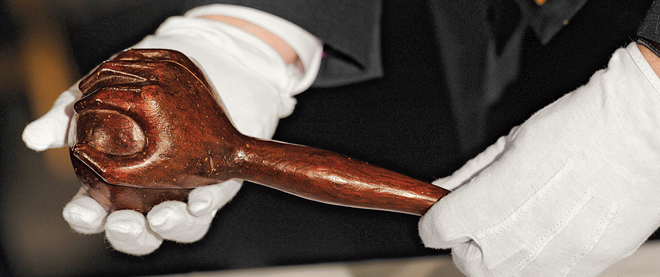Captain Cook’s club, a gift of the Nuu-chah-nulth, comes closer to home
The wooden club was given to Captain James Cook by the chief of a Nuu-chah-nulth village in 1778
Share

The finely carved 32-cm yew club had to travel a long way before Margarita James got to see it. Her clansfolk gave the treasured object to Captain James Cook back in 1778. That spring, he was sailing off the coast of what is now British Columbia, looking for the Northwest Passage. Cook moored his ship in the sheltered cove near Yuquot, a Nuu-chah-nulth village, on Vancouver Island’s Nootka Sound. It is believed that Chief Maquinna, the direct ancestor of the Mowachaht-Muchalaht First Nation’s current leader, gave the sculpture to Cook before the famed explorer continued north to survey the foggy inlets of the Pacific Northwest.
Now, thanks to the goodwill of art collector Michael Audain, the artifact is back in B.C. and on public display after a 234-year absence. James was there when the club arrived at University of British Columbia’s Museum of Anthropology from New York in late March. “It was overwhelming,” recalls James, the president of the Land of Maquinna culture society. “You could almost feel the power of the elders, the power of the chief’s family that gifted it.”
Mystery surrounds the club’s use and symbolic meaning. It features a detailed hand grasping a sphere, which experts speculate may represent the sun, the moon or even a human head. While the museum houses other, less expertly carved yew clubs with the same motif, they are larger and less delicate, suggesting that the club given to Cook served a ceremonial rather than a practical purpose.
Cook never found the Northwest Passage. Instead, he made his way south to Hawaii, where he was stabbed to death by the local population. The club, along with an array of other treasures in his possession, first went to Cook’s widow, Elizabeth, after the survivors of the voyage returned to England in 1780. It then began a long journey through the hands of art dealers, collectors and history buffs. “We know where it’s been every single moment of its life,” says Canada’s renowned Aboriginal art dealer Donald Ellis, to whom the club was sold last year from the estate of American antique collector George Terasaki.
According to Ellis, Elizabeth sold it to Sir Ashton Lever, a London aristocrat who housed it in his Leverian Museum. In 1806, Lever, then bankrupt, was forced to auction off his collection, and the club was acquired by another owner in England. It stayed in that family until the 1950s, says Ellis, when it was auctioned off again. The club was passed from a New York art dealer to a Washington family, and then back to New York when Terasaki bought it three years ago. That’s when Ellis became interested. “It’s a remarkable sculpture,” he says. “To be able to hold something with that much history, that was once in the hands of Captain Cook, is pretty remarkable.”
After acquiring the club, valued at $1.2 million, Ellis learned that Audain, a Vancouver-based philanthropist and prominent figure in Canada’s art scene, was interested in purchasing the club. Audain is known for donating Aboriginal artwork that has been taken away from the West Coast of B.C. and kept in private collections and museums in Europe and the eastern United States. “I was aware of the fact that if he acquired it, he would gift it,” says Ellis, explaining why he sold the club to Audain, who then donated it to UBC, making it the only piece from Cook’s collection held by a Canadian museum.
Of all the indigenous artwork of North America, Africa and Australia, that of the Pacific Northwest is thought to be the most sophisticated, Audain says. “Art-making in British Columbia did not start with Emily Carr,” he adds. “It’s been going on for thousands of years. It’s part of our heritage.”
Karen Duffek, a curator at the UBC anthropology museum, says that having the prized object back in B.C. presents an opportunity to study it not just as a relic of Cook’s venture to the Pacific Northwest, but as a symbol of the culture and history of the province’s Aboriginal peoples. “This is almost like a beginning,” says Duffek. “People can study it and especially make connections again between the Nuu-chah-nulth and this piece.”
The club—like so many other Nuu-chah-nulth artifacts—is yet to return to Nootka Sound. James says that no one in Yuquot carves items like that now, and that there is little opportunity for youth to connect with the traditions of the culture they were born into. “There are a lot of gaps in terms of being proud of First Nations, being proud of our history,” James says. “Our young people need to learn about it.” That’s why the Mowachaht-Muchalatht First Nation’s ultimate goal is to build a cultural centre that will house significant objects like the club.
Until then, James and her community can take comfort in knowing that after such a long journey, their chief’s treasure is a lot closer to home.